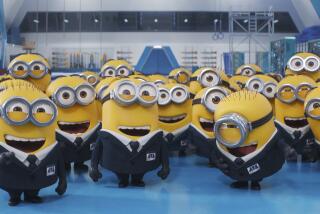Alcohol Activists Want to Cage Bud’s Lizards
- Share via
“We could’ve been huge,” read billboards and ads for Anheuser-Busch Inc. Budweiser beer, featuring their popular lizard pitchmen, Frank and Louie.
Actually, the reptiles are huge. Their increasing presence in widely distributed licensed products and on the Internet has alcohol-awareness groups seeing Budweiser red. They say the lizards have something in common with the recently departed Joe Camel: They appeal to children.
“They and other brewers know what the demographics look like. They’re looking at a gold mine in this young generation coming up,” said George Hacker, director of the Alcohol Policies Project of the Washington, D.C.-based Center for Science in the Public Interest. “[Beer companies] are willing to take risks. Their industry is highly competitive. . . . I think they calculate to do whatever they can get away with.”
Anheuser-Busch officials adamantly deny they are aiming at children. It is clear, however, that the animated characters are becoming ubiquitous. Budweiser distributors recently stocked local drugstore chains such as Sav-On and Rite Aid with battery-operated “talking” plastic mugs, featuring the lizards’ equally popular predecessor, a cartoon frog that croaks “Bud-WEIS-er.” You can buy a lizard version on Budweiser’s Web site, along with mouse pads, caps and other items.
A new computer screen saver that can be downloaded free of charge from the Bud site (https://www.budweiser.com) has proved extremely popular as well. Though the Web site purports to “card” visitors, children can easily type in a fake birth date and sail into the promotional site.
Anheuser-Busch executives declined to be interviewed for this story. Jack Dougherty, a spokesman for the company’s Consumer Awareness and Education initiative, sent a statement that said Anheuser-Busch’s licensed merchandise is “intended for adults. . . . To ensure that beer-themed merchandise is enjoyed by adults, Anheuser-Busch licensing contracts require that beer-themed clothing . . . be manufactured only in adult sizes and not positioned near children’s items in retail stores.”
Diana Conti, executive director of the San Rafael-based Marin Institute for the Prevention of Alcohol and Other Drug Problems, countered that Anheuser-Busch has taken these positions only under pressure.
“Kids today want extra-large sizes, so the size thing is no protection,” said Conti. As for selling Bud clothing in children’s sections, Conti said that in late 1996, a Marin County J.C. Penney store pulled Budweiser frog clothing from its back-to-school section only after receiving complaints.
Despite ongoing debate over the characters since the frogs were introduced in 1995, Anheuser-Busch has remained committed to its advertising strategy. At the company’s annual shareholders meeting two weeks ago in Williamsburg, Va., a small group of activists who own stock asked Chief Executive August Busch III to stop using cartoon characters in Bud ads.
“He had his director of consumer awareness and education [Francine Katz] answer the question,” Conti said in a phone interview. “[Katz] said they don’t think the ads have any effect on children or on underage drinking. They always say that ads don’t make people drink.”
Still, Bud’s frogs and lizards are undeniably popular with children. Several groups have conducted studies indicating that the Bud commercials are among kids’ favorites. Manhasset, N.Y.-based Marketing Evaluations Inc.--an independent research firm that produces the Q scores--recently found that people of all ages are very fond of the Bud characters.
The Q scores are subscribed to by entertainment firms and marketers as an objective measure of popularity. Not only were Bud’s characters among the most popular tied to advertising, they ranked on a par with classic cartoon characters such as Warner Bros.’ Wile E. Coyote and Roadrunner.
Representatives of Anheuser-Busch say the company has spent nearly $200 million over the last 15 years on programs to combat underage drinking. Yet that number is dwarfed by the company’s advertising expenditures on the Budweiser brand. In 1997 alone, Budweiser spent about $205 million on advertising, according to New York-based Competitive Media Reporting.
Conti also said that Anheuser-Busch is breaking the Beer Institute’s voluntary advertising code, which states that companies in the industry will refrain from using any “cartoon character that is intended to appeal primarily to persons below the legal purchase age [and] has special attractiveness to such persons above and beyond the general attractiveness it has for persons above the legal purchase age.”
More to Read
Inside the business of entertainment
The Wide Shot brings you news, analysis and insights on everything from streaming wars to production — and what it all means for the future.
You may occasionally receive promotional content from the Los Angeles Times.










